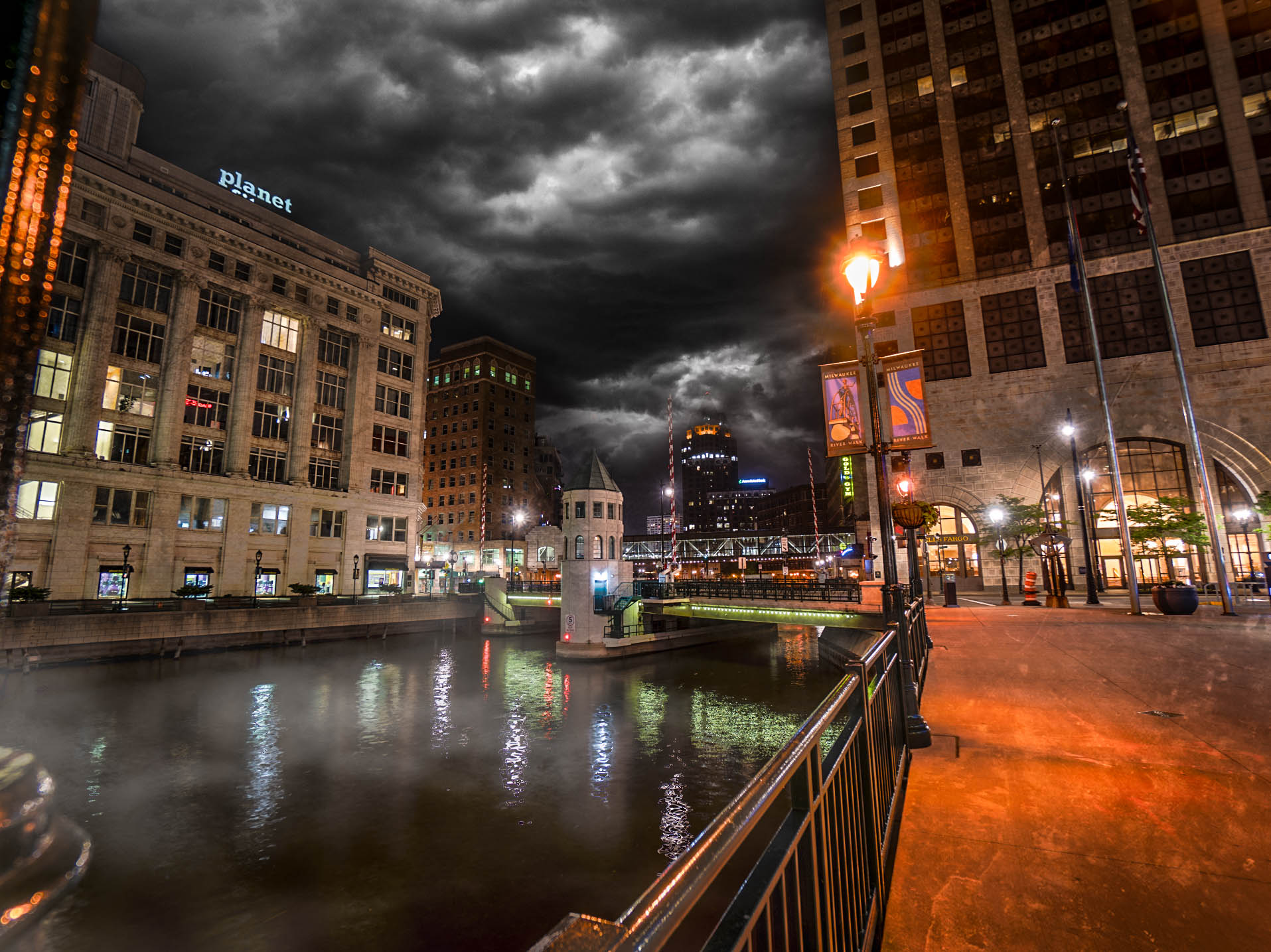
The Milwaukee Riverwalk is one of the most iconic promenades in Wisconsin’s Brew City and is enjoyed by walkers, joggers, bikers, and nature lovers alike. This free, public amenity is treasured by residents, but only a few of them know about the tormented history that lies underneath every step of this cursed walkway.
Join Brew City Ghosts on a stroll along this popular landmark, and learn why this particular area of the river seems to attract death, confusion, mystery, and chaos.
QUICK FACTS:
The 1845 Milwaukee Bridge War pitted conflicting groups from different areas of the city: Solomon Juneau’s Juneautown on the east, Byron Kilbourn’s Kilbourntown on the west, and George H. Walker in the south, with Walker’s Point.
There was a famous rivalry between Solomon Juneau and Byron Kilbourn specifically, as Kilbourn had been trying to isolate Jeneautown in an attempt to make it dependent on Kilbourtown. He also failed to correctly display Jeneautown on his 1835 street grid of the city, leaving it blank on the map, therefore misdirecting boat captains selling goods away from the east side of town.
Tensions further rose after a schooner rammed into Kilbourntown’s Spring Street Bridge on May 3, 1845, leading some to speculate that infuriated east ward residents actually paid the vessel’s captain to hit the bridge on purpose. In response, west warders decided to destroy Jeneau’s Chestnut Street Bridge, declaring it an “insupportable nuisance.”
What followed were weeks of scrimmages, arguments, and violence, leaving several injured but, thankfully, none dead. The conflict escalated to the point where East Waders destroyed the remainder of the Spring Street Bridge in retaliation.
Tempers eventually cooled, and finally, on January 31, 1846, the three sides of town were united, and the city of Milwaukee was formed. But to this day, many Milwaukee residents claim there are several irreversible differences between the east and west sides of town, an echo of the once-famous rivalry between Kilbourn and Juneau.
While the actual Milwaukee Riverwalk as residents know it today wasn’t completed until the mid-1990s, the blood-stained shores of the Milwaukee River have been there for centuries—and have certainly seen it all.
The story of the Milwaukee Riverfront is a fairly recent one, as the project was only completed a little over 30 years ago. But while its history might not be extensive, it certainly is colorful. For years, the land along the Milwaukee River in downtown Milwaukee remained in a state of disarray. Running through the heart of the city, the river had once been a beacon of commerce and recreation for Milwaukee residents but, with time, had been neglected.
But after a multi-million dollar Federal court-ordered cleanup mandate was imposed on the city, The Department of City Development began thinking of bigger plans for the riverfront. They envisioned a plan that would include riverwalks, public programming, the revitalization of downtown spaces, and riverfront developments, including housing, entertainment, and new restaurants.
Property owners and the city of Milwaukee reached a public-private partnership to make it happen, and the first segment of the Milwaukee Riverwalk was built in 1985, with the remainder later being completed in 1997.
It’s long been rumored that the restless spirits from Milwaukee’s past have taken to haunting the Riverwalk due to the painful atrocities that possibly brought about their deaths. Countless bodies have washed up on surrounding shores, leading some to suspect that their troubled souls continue to haunt the Riverwalk from beyond the grave, perhaps seeking revenge for the violence enacted on them decades or even centuries ago.
Are these the souls of unknown Bridge War soldiers who lost their lives while fighting, eternally doomed to feud with their neighbors? Or are they the ghoulish apparitions of mafia victims, who are said to have been dumped in the Milwaukee River for disrespecting the city’s major crime family? While it remains uncertain, any visitor will agree: there’s a dark energy that plagues the shadowy stretch of the Milwaukee Riverwalk, which gets even more bone-chilling after the sun goes down.
Similarly to the nearby city of Chicago, the Milwaukee River was heavily polluted throughout the latter half of the 20th century, posing an environmental hazard to the aquatic inhabitants in the water and the people on land. In fact, the pollution got so bad that Federal courts had to order the city of Milwaukee to clean out the water in 1985, leading to a massive infrastructure project that took well over a decade to complete.
City officials worked to flush the Milwaukee River with clean lake water throughout the summer of that year, which greatly improved water quality. So even though the waters of the Milwaukee River may be dirtied by the sins of the city’s past, it’s only metaphorical for the most part.
Today, the Milwaukee Riverwalk is a particularly trendy and sought-out part of town and features some of the most vibrant neighborhood spots, from breweries to sidewalk cafes to shops, to nightlife. The riverwalk ties together three distinct riverfront neighborhoods: the Historic Third Ward, Downtown, and Beerline B. Ironically, over a century ago, bridges were a great source of controversy that divided Milwaukee’s neighborhoods.
But today, the Riverwalk is an adamant reminder that the city is better when it’s together. For more on Wisconsin’s most haunted locales, visit our blog, and be sure to keep up with US Ghost Adventures on Facebook, Instagram, and TikTok.
Sources Cited:
https://milwaukeeriverkeeper.org/milwaukees-bridge-war/
https://en.wikipedia.org/wiki/Milwaukee_Bridge_War
https://city.milwaukee.gov/DCD/Projects/RiverWalk/RiverWalk-History